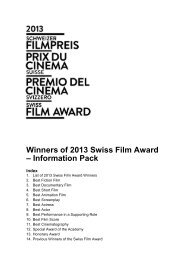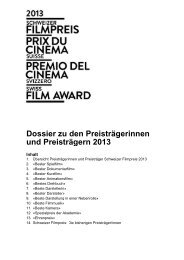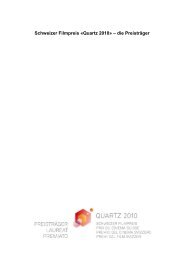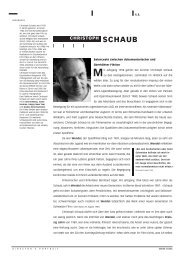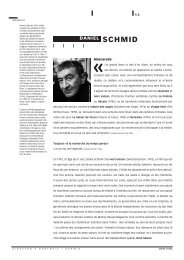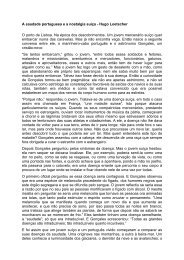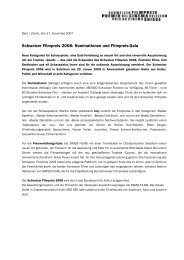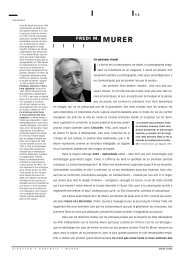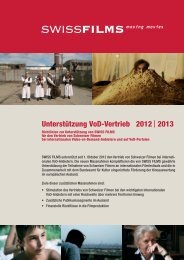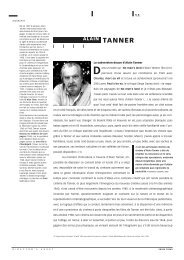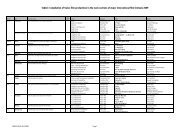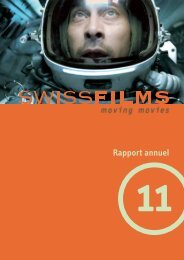Director's Portrait Fredi M. Murer - Swiss Films
Director's Portrait Fredi M. Murer - Swiss Films
Director's Portrait Fredi M. Murer - Swiss Films
You also want an ePaper? Increase the reach of your titles
YUMPU automatically turns print PDFs into web optimized ePapers that Google loves.
FILMOGRAPHY<br />
1962 Marcel<br />
1965 Pazifik – oder die Zufriedenen<br />
1965 Balance<br />
1965 Sylvan<br />
1966 Chicorée: Elf schizofragmentarische<br />
Aufzeichnungen<br />
über das Leben des Comte<br />
Ivan Merdreff<br />
1966 Bernhard Luginbühl<br />
1967 High and Heimkiller<br />
1969 Vision of a Blind Man<br />
1969 2069 – oder dort, wo sich<br />
Futurologen und Archäologen<br />
gute Nacht sagen<br />
1969 Sad-is-fiction<br />
1972 Passagen<br />
1973 Christopher & Alexander<br />
1974 Wir Bergler in den Bergen<br />
sind eigentlich nicht schuld,<br />
dass wir da sind<br />
1979 Grauzone<br />
1985 Höhenfeuer<br />
1987 Sehen mit anderen Augen<br />
1990 Der grüne Berg<br />
1998 Vollmond<br />
2004 Downtown Switzerland<br />
(Co-Director)<br />
2006 Vitus<br />
D I R E C T O R ’ S P O R T R A I T<br />
> A visual thinker<br />
FREDI M.<br />
ible amount of empathy, produced his first major documentary film, We mountain people in the<br />
mountains aren’t actually to blame for being here. But is this really a documentary? In terms<br />
of the absolute authenticity of the chronicling, the answer is yes; but in terms of the image and<br />
sound structure, the way it is edited into cyclical units, and the prosody of its individual parts,<br />
<strong>Murer</strong> has taken his cue from the direct, narrative style of modern European cinema.<br />
The basic premise is the magical “ring” that holds the world – the village, the family, the<br />
mountain region – together. At the centre of the film, the ring is evoked by the prayer song of<br />
a shepherd in front of a cabin and in the family circle, but the film itself essentially conjures it<br />
up throughout. Of course, the vulnerability of this “circle of peace” does not escape the film-<br />
maker, yet, without suppressing his sorrow, he still manages to recreate the “ring” in his own way,<br />
without nostalgia, from its surviving elements and through his cinematic gestures. The Green<br />
Mountain, one of <strong>Murer</strong>’s two major documentary films from<br />
the heart of Switzerland, can be seen as a more sombre echo<br />
of We mountain people in the mountains… The planned con-<br />
struction of a storage facility for radioactive waste brings the<br />
vulnerability of the “ring” into painful relief. This film depicts the<br />
complex issues at stake when the generation of go-getters and<br />
the civilization of the protectors and nurturers clash head-on. F. M. <strong>Murer</strong> dedicated this film,<br />
which is only saved from being an apocalyptic vision by the hope it places in the next generation,<br />
to the children and children’s children of the mountain farmers on the Wellenberg. Its central<br />
theme was to come to the fore again eight years later, in Full Moon.<br />
The three feature films in <strong>Murer</strong>’s filmography are, in terms of theme and iconography,<br />
almost inseparable from his documentary work and each other – in short, they are inextricably<br />
bound up with the job of film-making.<br />
MURER<br />
Zones expands on <strong>Swiss</strong> Made 2069 and also picks up the thread of the first film about<br />
mountain people. The main character, Alfred, whose job is to spy on others, becomes a sleuth<br />
and saves himself in the nick of time by finally listening to his own inner voice. The deaf boy in<br />
Höhenfeuer (Alpine Fire) (1985) lives in a world of touch and sight; only his sister, Belli, under-<br />
stands and loves his heightened sensitivity, and the two are forced to save each other, the life<br />
of their unborn child and their world. With incredible boldness of dramatic invention and a magi-<br />
cal clarity of vision and sensitivity, <strong>Murer</strong> champions the cause of nature, life and the future. In<br />
extremis, parricide and following our own infallible intuition become the only options. This is the<br />
point of departure of Full Moon, <strong>Fredi</strong> M. <strong>Murer</strong>’s latest film: twelve children disappear without<br />
1.2.<br />
People who’ve got something to<br />
tell usually have a stock of<br />
stories, regardless of what sets<br />
them going. <strong>Murer</strong>'s stories are<br />
picture stories characterized<br />
by quiet observation and stimulated<br />
by strong memories.<br />
Walter Ruggle, 1995<br />
SWISS FILMS



